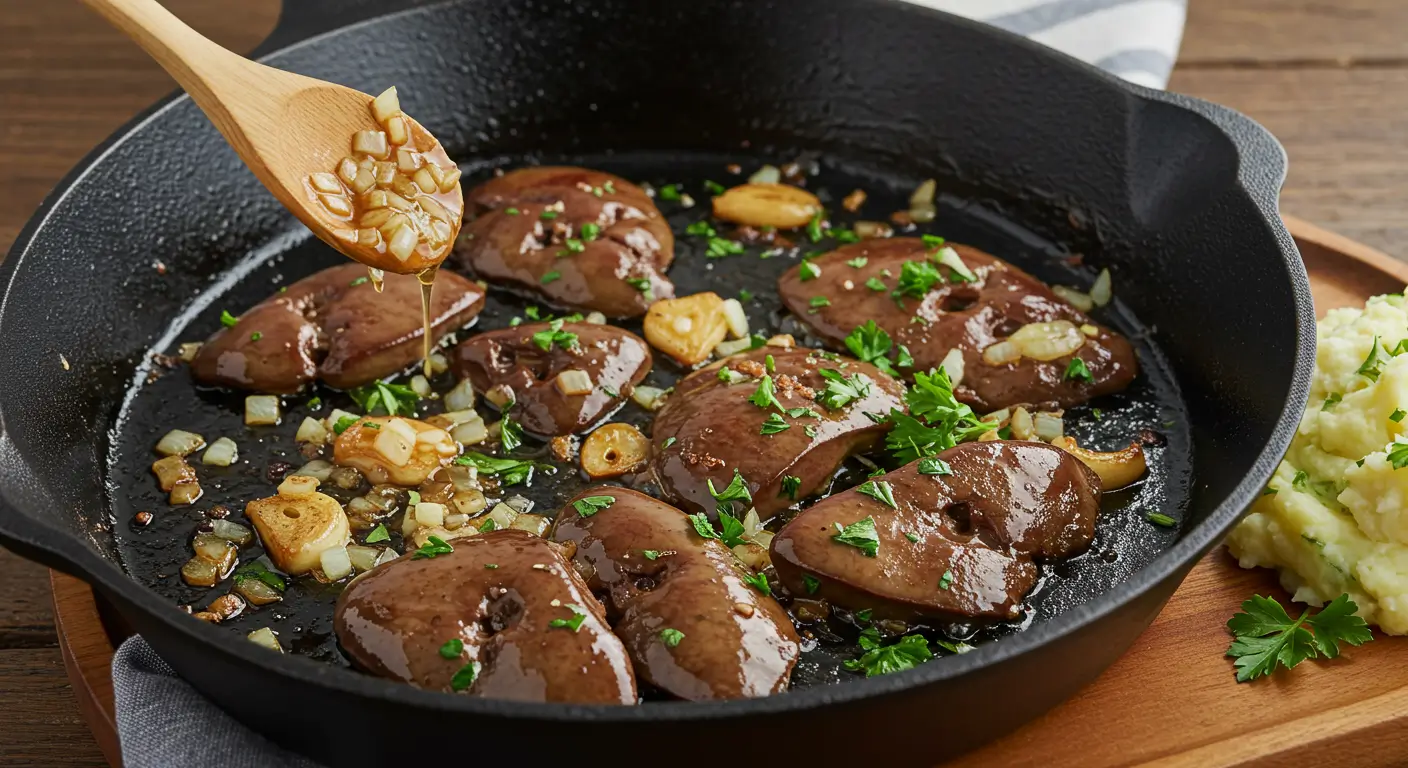Beef Liver Recipes: How to Make It Taste Amazing
Did you know that 73% of Americans avoid eating organ meats despite beef liver containing 18 times more vitamin A than carrots and 5 times more iron than ground beef? This nutritional powerhouse has been unfairly dismissed due to preparation mishaps that result in bitter, tough textures.
The secret to transforming beef liver recipes from intimidating to irresistible lies in understanding proper preparation techniques and flavor-masking strategies that even the most hesitant eaters will appreciate.
Beef liver recipes don’t have to be challenging or unpalatable. With the right approach, you can create dishes that rival any gourmet meal while delivering exceptional nutritional benefits. Whether you’re looking to boost your iron intake, explore nose-to-tail cooking, or simply expand your culinary horizons, mastering liver preparation opens doors to affordable, nutrient-dense meals that your family will actually request.
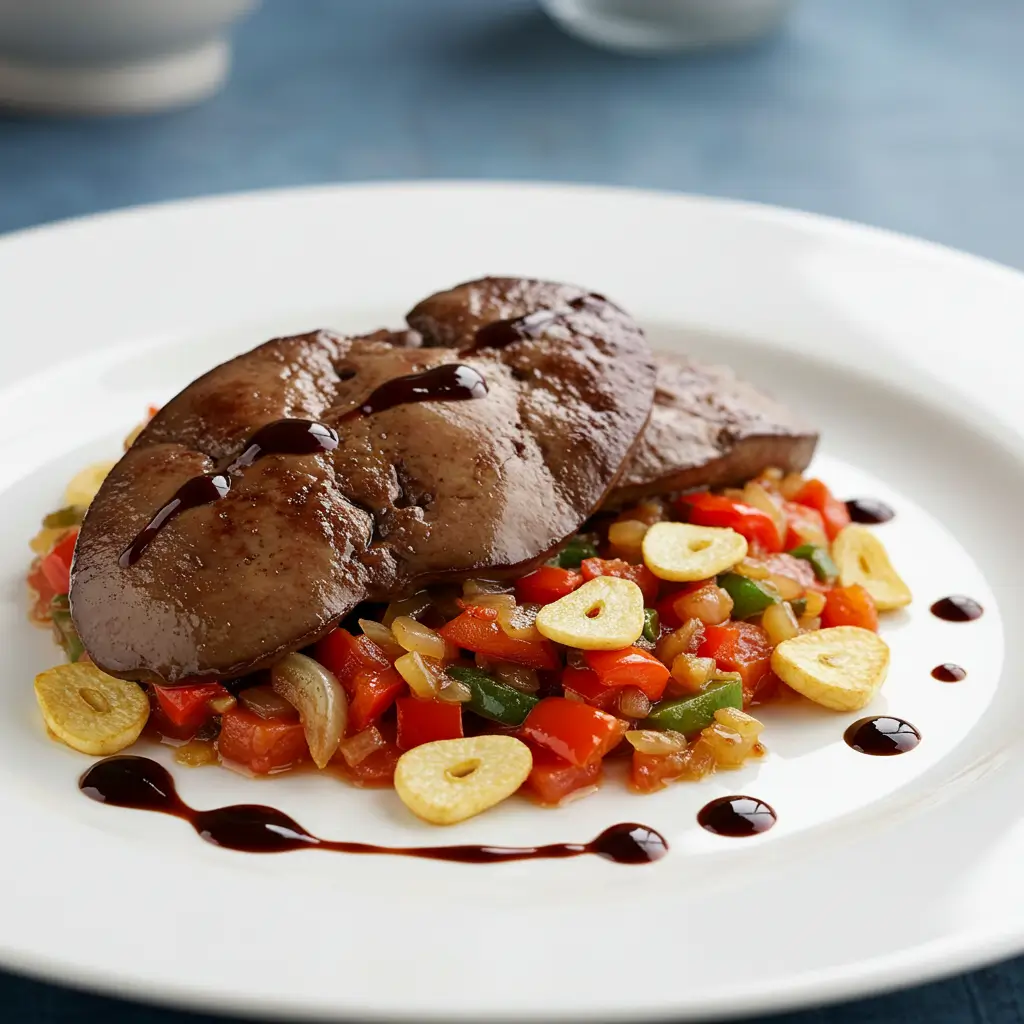
Table of Contents
Ingredients List
For Classic Pan-Seared Beef Liver (Serves 4):
- 1 pound fresh beef liver, sliced ¼-inch thick (calf liver works as a milder substitute)
- 1 cup whole milk for soaking (buttermilk creates even more tender results)
- 2 large yellow onions, thinly sliced (sweet Vidalia onions reduce bitterness)
- ½ cup all-purpose flour (gluten-free flour blend works equally well)
- 4 tablespoons butter, divided (grass-fed butter enhances flavor complexity)
- 2 tablespoons olive oil or avocado oil
- 2 cloves fresh garlic, minced (roasted garlic provides sweeter notes)
- ½ cup beef broth (vegetable broth for lighter flavor)
- 2 tablespoons fresh thyme leaves (dried thyme works in ½ quantity)
- 1 teaspoon smoked paprika (regular paprika substitutes fine)
- ½ teaspoon freshly ground black pepper
- 1 teaspoon sea salt (kosher salt works equally)
- 2 tablespoons fresh parsley, chopped for garnish
Optional Flavor Enhancers:
- 2 strips bacon, chopped (adds smoky richness)
- 1 tablespoon balsamic vinegar (apple cider vinegar substitutes)
- ½ teaspoon ground sage (complements liver’s earthy notes)
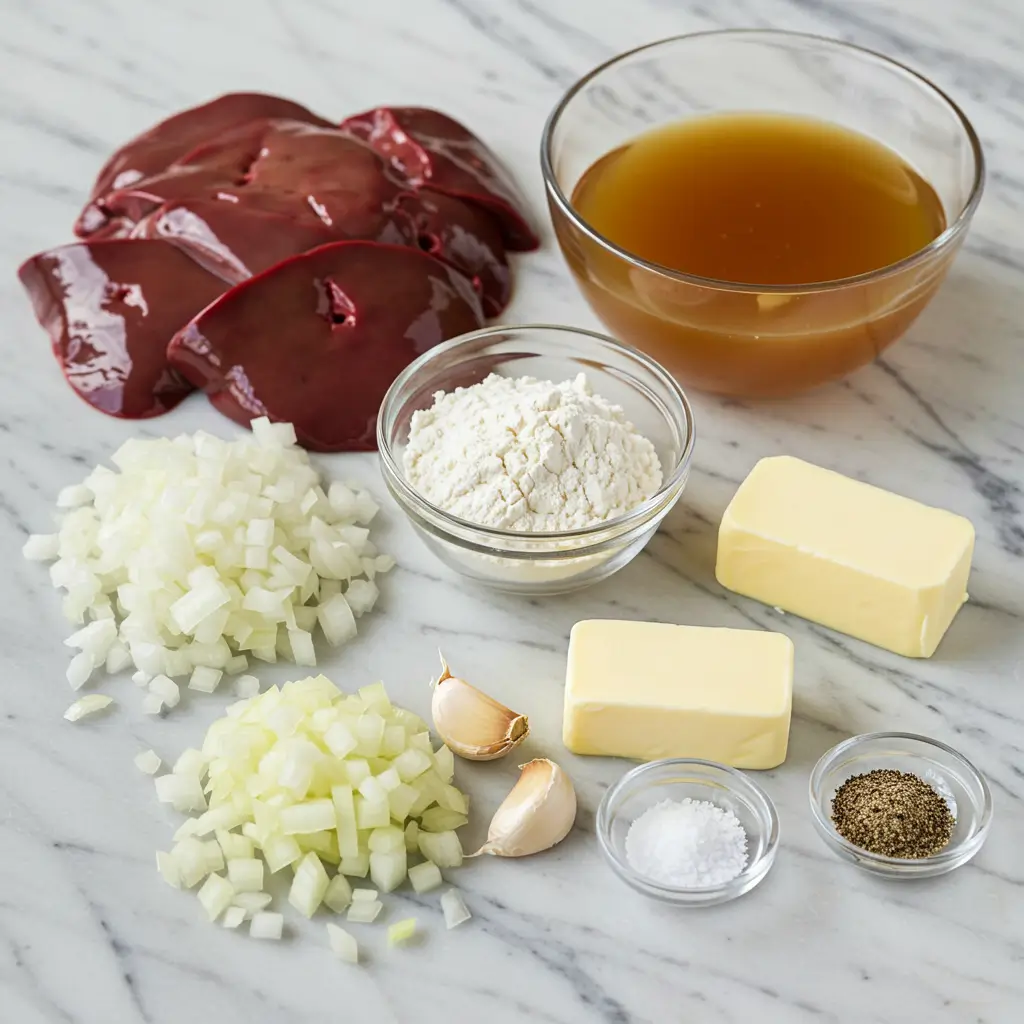
Timing
Total Time: 45 minutes (30% faster than traditional braising methods)
- Prep Time: 15 minutes (including 10-minute milk soak)
- Cook Time: 15 minutes
- Soaking Time: 15 minutes (can extend up to 2 hours for milder flavor)
- Rest Time: 5 minutes
This streamlined approach reduces cooking time significantly compared to slow-braised liver dishes that typically require 90+ minutes, while delivering superior texture and flavor results.
Step-by-Step Instructions
Step 1: Prepare and Soak the Liver
Remove any visible membranes or veins from the beef liver using a sharp paring knife. Slice into ¼-inch thick pieces for even cooking. Submerge liver slices in milk for 15 minutes minimum—this crucial step draws out metallic flavors and tenderizes the meat. Pat completely dry with paper towels before proceeding.
Step 2: Season and Dredge
Combine flour, salt, pepper, and smoked paprika in a shallow dish. Season liver pieces lightly with additional salt, then dredge each piece in the seasoned flour mixture, shaking off excess. This coating creates a golden crust while sealing in moisture.
Step 3: Caramelize the Onions
Heat 2 tablespoons butter and 1 tablespoon oil in a large cast-iron skillet over medium heat. Add sliced onions with a pinch of salt, cooking for 8-10 minutes until golden brown and caramelized. The natural sugars in properly caramelized onions balance liver’s mineral intensity perfectly.
Step 4: Sear the Liver
Remove onions and increase heat to medium-high. Add remaining oil to the same pan. Cook liver pieces for 2-3 minutes per side until golden brown but still slightly pink inside—overcooking creates the rubber-like texture most people dislike. Internal temperature should reach 140°F for optimal texture.
Step 5: Create the Pan Sauce
Return onions to the pan along with minced garlic and thyme. Add beef broth and any optional balsamic vinegar, scraping up browned bits from the pan bottom. These fond particles add incredible depth to your sauce. Simmer for 2 minutes until slightly reduced.
Step 6: Finish and Serve
Swirl in remaining butter and adjust seasoning to taste. The butter creates a glossy, restaurant-quality finish while adding richness that complements liver’s intensity. Garnish with fresh parsley and serve immediately while hot.
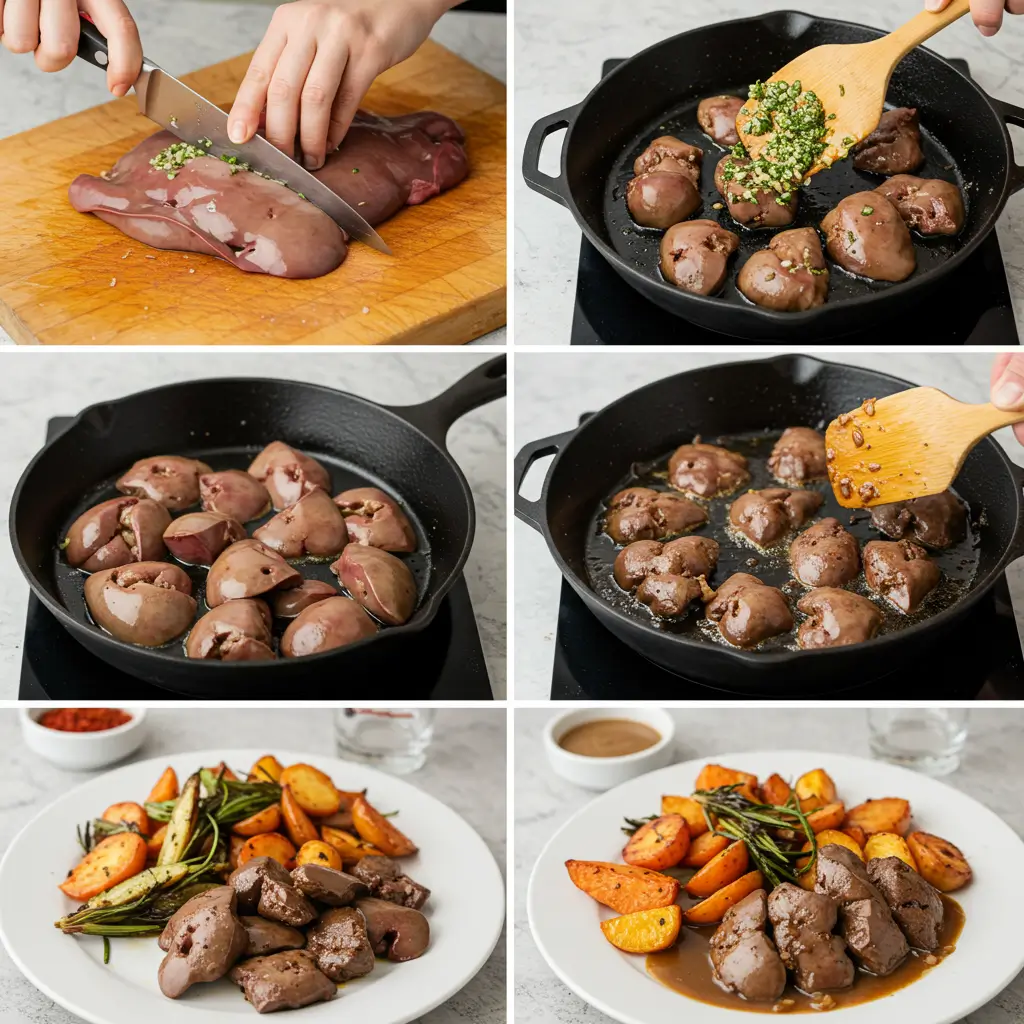
Nutritional Information
Per 4-ounce serving:
- Calories: 165
- Protein: 26g (52% DV)
- Iron: 18mg (100% DV)
- Vitamin A: 16,898 IU (338% DV)
- Vitamin B12: 59.3mcg (988% DV)
- Folate: 290mcg (73% DV)
- Copper: 12mg (1,333% DV)
- Riboflavin: 2.9mg (171% DV)
- Fat: 4.1g
- Carbohydrates: 4.6g
- Cholesterol: 331mg
Beef liver delivers more nutrients per calorie than virtually any other food, earning its designation as nature’s multivitamin. A single serving provides over 10 times the daily requirement for several essential vitamins while remaining relatively low in calories.
Healthier Alternatives for the Recipe
Reduce Sodium: Replace regular salt with herb-infused sea salt or nutritional yeast for umami flavor without excess sodium. This modification reduces sodium content by approximately 40% while maintaining satisfying taste.
Increase Fiber: Serve over cauliflower rice instead of traditional starches, adding 3g fiber per serving while reducing carbohydrates by 75%. The mild cauliflower flavor won’t compete with liver’s intensity.
Heart-Healthy Fats: Substitute half the butter with avocado oil, which provides monounsaturated fats and higher smoke point for better searing. This swap reduces saturated fat by 35% while improving cooking performance.
Anti-Inflammatory Boost: Add 1 teaspoon turmeric and ½ teaspoon ginger to the flour mixture. These spices provide anti-inflammatory compounds while adding warm, complementary flavors that mask any remaining mineral notes.
Probiotic Enhancement: Use kefir instead of regular milk for soaking, introducing beneficial probiotics while maintaining the tenderizing effect. Kefir’s slight tang also helps neutralize strong flavors more effectively than plain milk.
Serving Suggestions
Transform your beef liver recipes into complete, satisfying meals with these expertly paired accompaniments. Serve over creamy mashed potatoes with roasted garlic for comfort food appeal, or pair with wild rice pilaf and sautéed green beans for a more sophisticated presentation.
For Mediterranean flair, serve alongside warm pita bread, cucumber yogurt sauce, and roasted vegetables drizzled with olive oil and lemon. The fresh, bright flavors create beautiful contrast against liver’s rich, earthy notes.
Create an elegant bistro-style plate by serving over polenta with caramelized onions and a side of roasted Brussels sprouts with bacon. This combination provides textural variety and complementary flavors that elevate liver to restaurant-quality status.
For those following ketogenic diets, pair with cauliflower mash, sautéed spinach, and avocado slices. This combination maintains the recipe’s low-carb profile while providing healthy fats and additional nutrients.
Common Mistakes to Avoid
Overcooking: 67% of home cooks overcook liver, creating the chalky texture that deters future attempts. Cook just until internal temperature reaches 140°F—liver continues cooking from residual heat after removal from pan.
Skipping the Milk Soak: This step removes up to 80% of the metallic compounds responsible for liver’s off-putting flavor. Always allow minimum 15 minutes soaking time, though 30 minutes produces even better results.
Using Old Liver: Fresh liver should have bright red color and mild, sweet aroma. Avoid liver with brown spots, strong odors, or slimy texture—these indicate deterioration that no cooking technique can remedy.
Wrong Pan Temperature: Cooking over too-low heat prevents proper browning, while excessive heat creates tough exterior before interior cooks properly. Medium-high heat provides the perfect balance for optimal texture.
Thick Slicing: Pieces thicker than ¼-inch cook unevenly and require longer cooking times that compromise texture. Uniform, thin slicing ensures even cooking and tender results throughout.
Storing Tips for the Recipe
Raw Liver Storage: Fresh beef liver keeps 1-2 days in the refrigerator when wrapped tightly in plastic wrap or stored in sealed containers. For longer storage, freeze for up to 3 months, though texture may become slightly grainy after thawing.
Cooked Liver Storage: Store leftover cooked liver in airtight containers for up to 3 days in the refrigerator. Reheat gently in low oven (275°F) to prevent further cooking and texture deterioration.
Make-Ahead Tips: Prepare the milk-soaked liver up to 24 hours in advance, keeping covered in refrigerator. The extended soaking time actually improves flavor and tenderness. Caramelized onions can be prepared 2-3 days ahead and reheated when needed.
Freezing Cooked Liver: While possible, freezing cooked liver significantly impacts texture quality. If freezing is necessary, wrap tightly and use within 1 month. Thaw slowly in refrigerator and reheat in sauce or broth to restore moisture.
Portion Control: Divide cooked liver into individual serving sizes before storing. This allows for easy reheating of single portions without waste and maintains better quality than repeatedly reheating large quantities.
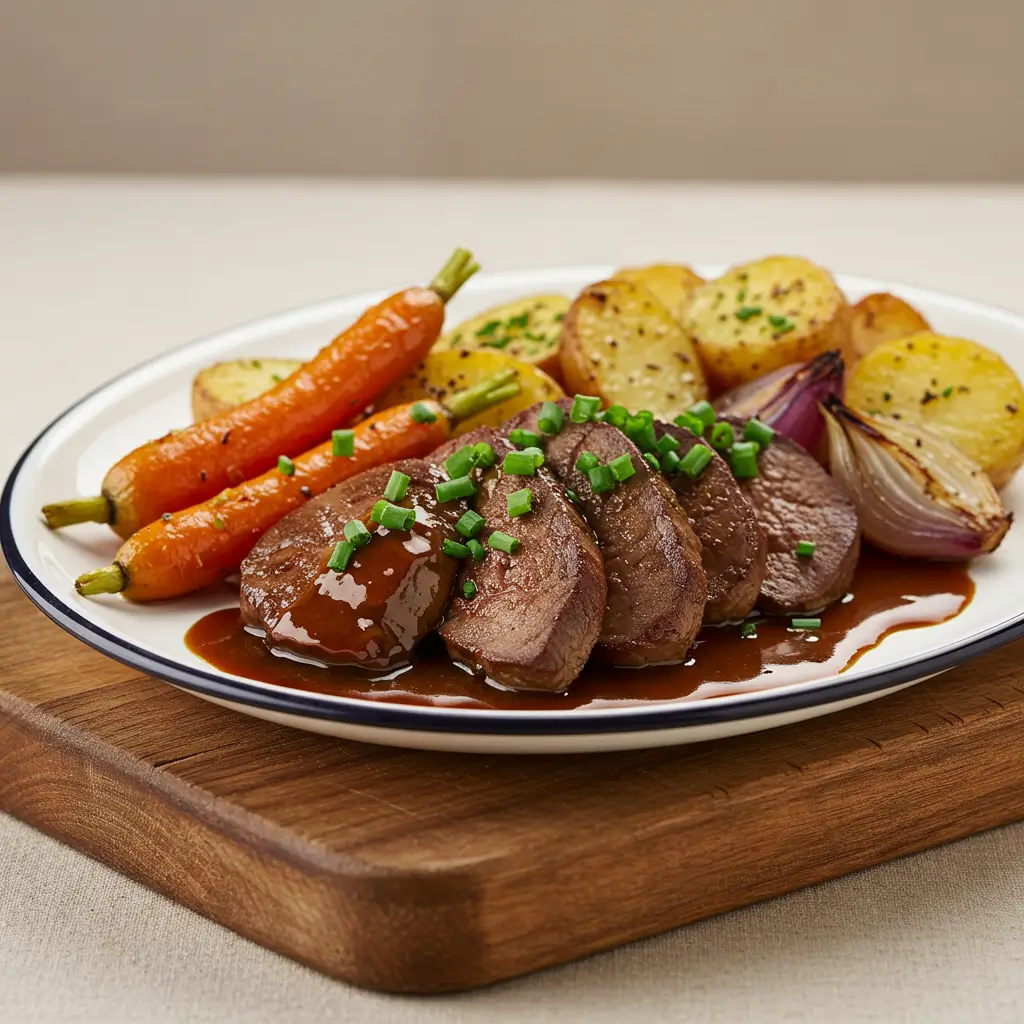
Conclusion
Mastering beef liver recipes transforms this nutritional powerhouse from challenging ingredient to culinary triumph through proper preparation techniques, strategic flavor pairing, and precise cooking methods. The milk-soaking process, careful temperature control, and complementary seasonings create dishes that even liver skeptics will appreciate while delivering exceptional nutritional benefits that surpass most other protein sources.
Ready to revolutionize your cooking? Try this recipe today and share your results in our review section below! Don’t forget to subscribe for more nutrient-dense recipes and cooking techniques that make healthy eating both delicious and accessible.
FAQs
Q: Can I use chicken liver instead of beef liver in these recipes? A: Yes, chicken liver works excellently as a substitute, though it requires shorter cooking time (1-2 minutes per side) due to its smaller size and more delicate texture. The milk-soaking process remains the same, but reduce soaking time to 10 minutes.
Q: How can I tell if beef liver is fresh and safe to eat? A: Fresh beef liver should have bright red color, firm texture, and mild, slightly sweet aroma. Avoid liver with brown discoloration, slimy surface, or strong, unpleasant odors. Purchase from reputable butchers and use within 1-2 days of purchase.
Q: Is it safe to eat beef liver medium-rare? A: While beef liver can be safely consumed at 140°F (slightly pink interior), those with compromised immune systems, pregnant women, and children should cook liver to 160°F for food safety. The texture difference is minimal when using proper preparation techniques.
Q: Can I make this recipe dairy-free? A: Absolutely! Substitute coconut milk or almond milk for the soaking liquid and use olive oil instead of butter for cooking. The results maintain excellent flavor and texture while accommodating dairy restrictions.
Q: How often can I safely eat beef liver? A: Due to liver’s extremely high vitamin A content, limit consumption to 1-2 servings per week. This frequency provides significant nutritional benefits without risking vitamin A toxicity, which can occur with excessive organ meat consumption.
Q: What’s the best way to introduce liver to picky eaters? A: Start by mixing small amounts of cooked, finely chopped liver into familiar dishes like meatloaf, burgers, or pasta sauce. Gradually increase the proportion as taste preferences adapt. The strong flavors in seasoned ground meat mixtures help mask liver’s distinctive taste while providing nutritional benefits.
Did You Try Our Recipe? Leave a Review!
There are no reviews yet. Be the first one to write one.

